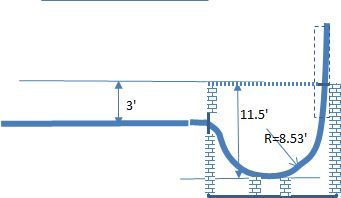We do a good deal of underground cable calculations in conduit for voltages between 12kV and 230kV. We use a program called CYMCAP made by CYME (now owned by Eaton). At riser poles and transitions, you often have to dive a good bit deeper to fit in the 90 degree turn of the conduit. This causes your cable to be buried up to 10 feet deep where your normal run is 3' deep or so. When we run the calculations, we pick out the worst case places in the conduit runs and analyze those. These are you places where the cable is deepest, next to other cable runs, etc. According to the folks at CYMCAP, we have to consider the conduit elbow area as a deepest point. This of course makes our cable bigger. Some of our customers (utilities and developers) have decided that they will negate the effect of the elbow due to the chimney effect of the hot air rising out of the end of the elbow into free air. This of course assumes you do not plug the end of the conduit or if you do you ventilate the conduit somehow. CYMCAP says this is wrong. So, what do you think? It is not a trivial question as ,for example, one run of 230kV cable is in duct that runs at 3' to top of concrete for 2000'. On each end the conduit dives to 10' to accommodate the elbow required for the bending radius of the cable. If you negate the elbow, you can use 2500kcmil cable. If you take into account the elbow and consider your worst case as 10', you must use 3500 or 4000 kcmil cable. This is a huge cost difference. I cannot find anything in IEEE that is clear about this. IEEE 1793 mentions the chimney effect and ventilation, but it provides no clear answer.
Navigation
Install the app
How to install the app on iOS
Follow along with the video below to see how to install our site as a web app on your home screen.
Note: This feature may not be available in some browsers.
More options
You are using an out of date browser. It may not display this or other websites correctly.
You should upgrade or use an alternative browser.
You should upgrade or use an alternative browser.
Underground High Voltage Cable Design Question
- Thread starter cwhite6
- Start date
- Status
- Not open for further replies.
davidbeach
Electrical
If you have a localized hot spot you can rely on the thermal conductivity of the (electrical) conductor to spread the heating out. I believe the NEC allows a heating condition that exists for less than 10% of the run to be ignored in the thermal derating calcs required by that code.
- Thread starter
- #3
I found the section in the NEC you referenced. That does help me for 34.5kV circuits. Now I need some help for the ones above that. My problem is I am being forced to use a deeper depth as my controlling one for cable selection. When you have a 2000' run of conduit that is 3' to top of concrete, a 10' section on each end should not be the ruling factor.
- Thread starter
- #5
Permissible minimum radius 2.6 m[8.53'], I think. Then the cable maximum depth will be 3’+8.53’=11.53'. The total length below 3' is pi*8.53’=26.7 feet. NEC maximum permissible 10 feet in order to neglect it.
In my opinion, you have to build a manhole and to put the cables in free air.

In my opinion, you have to build a manhole and to put the cables in free air.

bacon4life
Electrical
It seems like the chimney effect (if any) would be offset by the extra conductor in a radius.
Can you install fiber optic monitoring with one of your installations? We looked into using lios for monitoring 12 kV cables, but it hasn't gotten funded yet.
Although you are likely using thermal backfill everywhere, can you increase the thermal conductivity of the elbow sections? Perhaps a heat sink using vertical steel posts?
Can you install fiber optic monitoring with one of your installations? We looked into using lios for monitoring 12 kV cables, but it hasn't gotten funded yet.
Although you are likely using thermal backfill everywhere, can you increase the thermal conductivity of the elbow sections? Perhaps a heat sink using vertical steel posts?
When I worked for the utility we used conduit ventilators at the base of the pole to improve the chimney effect of the conduit. I never saw any calculations - this was before all the high power computers & software you have today. O-Z/Gedney (OZ/G) is one of the manufactures, they come in female to female (OZ/G catalog no. KVF-xxxx) and female to male (OZ/G catalog no. KVM-xxxx).
- Status
- Not open for further replies.
Similar threads
- Locked
- Question
- Replies
- 5
- Views
- 19
- Replies
- 5
- Views
- 8
- Question
- Replies
- 1
- Views
- 14
- Locked
- Question
- Replies
- 12
- Views
- 24
- Replies
- 4
- Views
- 17
